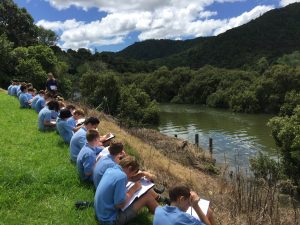May 29
MEDIA RELEASE
Whangarei’s archaeological gem captures imagination of students
A heritage site dating back hundreds of years has captured the imagination of students from Whangarei Boys High School.
Mair’s Landing / Tawatawhiti, just north of Whangarei’s CBD, contains a number of prehistoric and historic features – including a remnant Maori stone field garden, the remains of a coal chute associated with the Whau Valley Coal mine horse drawn tramway and Mair’s Landing itself – a stone wharf dating back to 1841. Interest in the extensive heritage site was sparked by a public talk given by Heritage New Zealand’s Northland staff as part of last year’s New Zealand Archaeology Week.
“I was told of the site by a friend who attended the talk, and so I got in contact with Bill Edwards of Heritage New Zealand in Kerikeri,” says Whangarei Boys High School Deputy Principal, Allister Gilbert.
“He was pleased that a school was interested in the history of the place, and supplied documents recording the archaeology of the Whangarei area and harbour as background material for the students. Heritage New Zealand people have been fantastic to work with.”
Bill, and his colleague Northland Archaeologist James Robinson, took 22 of the school’s staff members on a walking tour of the site – and the ideas for using the site as an outdoor learning environment grew from there. Mair’s Landing / Tawatawhiti was recently listed as a Historic Area, and research for the listing report has helped raise understanding of the site’s significance.
“The science and social studies teachers were enthusiastic about being able to walk classes to the site and back to school in 90 minutes, and a cross curricular unit was developed between the two faculties,” says Allister.
“The English Faculty then became involved with the project as they wanted to use it as a source of inspiration for writing. The Te Reo Maori teacher has also used it as a source of information and experience for te tuhi me te korero[writing and speaking activities].”
About 250 Year 9 students – split up into 10 teaching groups – visited the site earlier this year and took part in a number of activities including sketching the outline of Parihaka Pa across the Hatea River, one of the largest archaeological sites in New Zealand. The students also sketched the stone garden remnants and learned how the garden was used.
The boys also rolled up their sleeves and helped clean up the rubbish in the area that had come in from the road. Year 9 Horticulture students will also be involved in weed management of the site as part of their course working with Whangarei District Council.
“About 42 percent of the Year 9 students are Maori, and the ability to give these rangatahi pride and a place in the city is a really positive outcome of this cross curricular work,” says Allister.
“The response from all the boys has been positive, with growth in a sense of connectedness to the place they live in. The ability to weave the Tawatawhiti garden site – which is very early – with the Parihaka site has really put their history into perspective.”
The project has had other spin-offs that have impacted the students.
“The local museum, KiwiNorth, brought artefacts relating to Maori gardening and other tools to the school. We had them at the school for two days, with the Year 9 classes rotating through the display of Ko [digging sticks], Timo / Ketu [small wooden digging implements], Toki [adze], and Mahe [fishing sinkers] and Punga [anchor stone].
“This was the first time they have brought material out of the museum, and we were very privileged to have this opportunity. The source of the stone has triggered interest with the boys, and so the inquiry continues.”
Mair’s Landing / Tawatawhiti will continue to play a central part in Whangarei Boys High School’s learning – and the Year 9 cross curricular unit in particular.
“The school feels very close to the site and is looking forward to helping develop it, and hopefully getting access to a high enough standard that it can be open to the public as it is an easy walk from the popular Town Basin café and tourist precinct,” he says












Comments are closed.